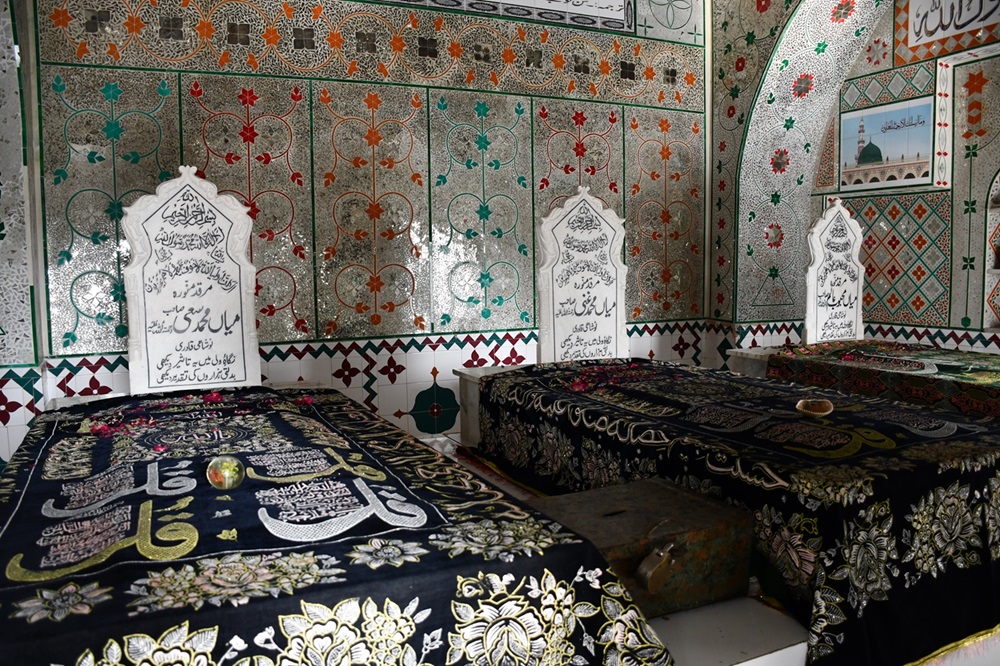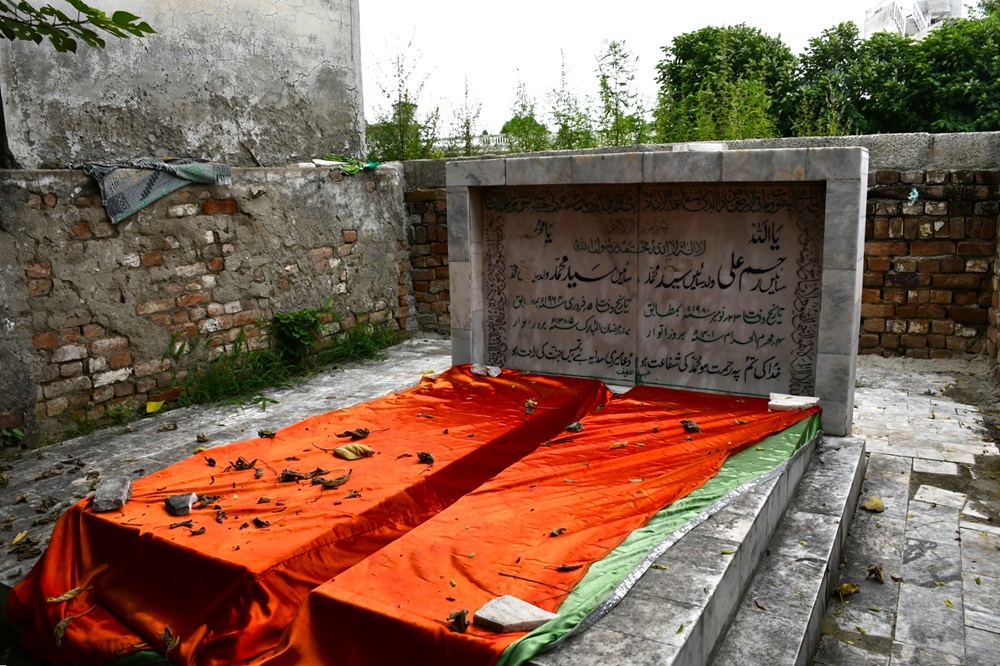Written by: Zulfiqar Ali Kalhoro
Posted on: January 07, 2025 |  | 中文
| 中文
Domes over the graves of Mian Muhammad sahe and Haji Mian Imdad Hussain. (Picture credits to Zulfiqar Ali Kalhoro)
Gujar Khan tehsil is home to several shrines of Qadiri Sufi saints located in various villages and towns. These shrines are recognized for their spiritual influence on the local community in their respective areas. One such village known for the shrine of Sufi saint Mian Muhammad Saee/ Sahe Qadiri Naushahi is Jairo Ratial, which is located approximately 12 km south of Gujar Khan town via Gulyana Road. He was a deputy (khalifa) of Syed Mir Kalan Badshah Qadiri Naushahi, whose shrine is located at Rokhia Sharif in Gujar Khan. Syed Mir Kalan Badshah Qadiri Naushahi was the deputy of Hafiz Qaimuddin Barqandaz Qadiri Naushahi (d.1765), who was himself a deputy of Pir Muhammad Sachiar Qadiri Naushahi (d.1707). Pir Muhammad Sachiar Qadiri Naushahi was a deputy of Haji Muhammad Naushah Ganj Bakhsh (d.1654), the founder of Naushahiyya Silsila.

Graves of Mian Muhammad Sahe, Mian Muhammad Ghani and Mian Mehboob Alam. (Picture credits to Zulfiqar Ali Kalhoro)
On the instruction of his spiritual master Hafiz Qaimuddin Barqandaz Qadiri Naushahi, Syed Mir Kalan Badshah Qadiri Naushahi spread Qadiriyya Naushahiyya Silsila in Gujar Khan tehsil. Muhammad Hanif Hanfi (1999:294) states in “Ruh Da Rishta” that Syed Mir Kalan Badshah Qadiri Naushahi had five prominent deputies (Khulfa), Mian Muhammad Saeed (Sahe), Syeda Mai Nawab Sahib Qadiri Naushahi, Mian Khair Muhammad Qadiri Naushahi (d.1783-84), Shaikh Muhammad Ji Qadiri Naushhai (d.1759), and Mian Muhammad Azeem Qadiri Naushahi. Except for the shrine of Mai Nawab Sahib Qadiri Naushahi, the shrines of all four deputies of Mir Kalan Badshah Qadiri Naushahi are located in different villages of Gujar Khan tehsil.
Mian Muhammad Sahe was born in the town of Gujar Khan. He belonged to the Chauhan Rajput caste. He received initiation into the Qadiriyya Naushahiyya Silsila from Syed Mir Kalan Badshah Qadiri Naushahi. Following his initiation, he proceeded to the village of Jairo Ratial, as directed by his spiritual mentor, to disseminate the teachings of the Qadiriyya Naushahiyya Silsila. Jairo Ratial became a thriving centre of Qadiriyya-Naushahiyya Silsila during Mian Muhammad Sahe Qadiri Naushahi’s time. Syed Sharif Ahmad Sharafat Naushahi (1971:151) states in Sharif ul Tawarikh” Vol.3, No. 4 that Syed Hyder Shah was a disciple of Mian Muhammad Saeed (he has written his name as Mian Muhammad Saeed) Qadiri Naushahi, who played a significant role in disseminating the teachings of his spiritual mentor. However, Mian Zafaryab Ali Qadiri Naushahi, the Sajjada Nashin (custodian) of Mian Muhammad Sahe Qadiri Naushahi Darbar, disputes this claim and rejects it outright. Mian Zafaryab Ali Qadiri Naushahi, whom I interviewed, argues that Mian Muhammad Sahe did not initiate anyone into the Qadiriyya Naushahiyya Silsila, meaning that he did not grant bayat (the formal pledge of allegiance) to anyone.
The shrine of Syed Hyder Shah is located in Rawalpindi’s Teli Mohalla. He had two prominent deputies: Mian Ghulam Hussain, whose shrine is in Islamabad's Maira Abadia and Syed Buzrug Shah, whose shrine is in Chak Beli Khan’s Bahiya Sharif village. I have visited both shrines and met the Sajjada Nashins to learn the history of the respective shrines.
Mian Muhammad Sahe Qadiri Naushahi's date of death is unknown. After he passed away, he was buried in the Jairo Ratial village. He left behind two sons: Mian Mehboob Alam and Mian Dost Ali. Mian Dost Ali died without any children. Mian Mehboob Alam Qadiri Naushahi became the Sajjada Nashin of the Mian Muhammad Sahe Qadiri Naushahi Darbar and continued his father's legacy. The exact date of Mian Mehboob Alam Qadiri Nauhsahi's death is unknown. He was laid to rest next to his father. Mian Mehboob Alam Qadiri Naushahi had three sons: Mian Muhammad Ghani, Mian Muhammad Wali and Mian Ali Zaman. After the passing of Mian Mehboob Alam Qadiri Naushahi, Mian Muhammad Ghani Qadiri Naushahi became the custodian of Mian Muhammad Sahe Qadiri Naushahi Darbar. Mian Muhammad Ghani Qadiri Naushahi continued the legacy of his grandfather, Mian Muhammad Sahe Qadiri Naushahi. Ishtiaq Ahmad Naushahi Sachiari (2021:134-135) writes in “Gujar Khan Men Faizan-e- Naushahiyya”, that Mian Muhammad Ghani Qadiri Naushahi had two deputies, Sain Syed Said Muhammad of Sud Gangal village and Raja Nek Muhammad of Gujar Khan’s Changa Bangial village. During the interview, Mian Zafaryab Ali Qadiri Naushahi told me that only Sain Syed Said Muhammad took bayat (an oath of allegiance to a Sufi master) from Mian Muhammad Ghani Qadiri Naushahi. Raja Nek Muhammad of Changa Bangial was only his disciple, not his deputy.

Graves of Sain Syed Said Muhammad and his son at Sud Gangal village. (Picture credits to Zulfiqar Ali Kalhoro)
I have visited Sud Gangal village several times to research sacred spaces. It is situated approximately 3 km from Rawat town, accessible via Rawat-Kallar Syedan Road. I visited the shrine of Sain Mian Bahauddin Naushahi in Sud Gangal village. Within the graveyard of Sain Mian Bahauddin Naushahi lies the grave of Sain Syed Said Muhammad, the son of Sain Fateh Muhammad. Sain Syed Said Muhammad, also known as Sain Saidu, passed away in 1964. Adjacent to his grave is that of his son, Sain Reham Ali, who died in 1980. The descendants of Sain Syed Said Muhammad currently reside in Moza Aban.
Mian Muhammad Ghani Qadiri Naushahi significantly contributed to the propagation of the Qadiriyya Naushahiyya Silsila. His deputies and disciples also played essential roles in disseminating his teachings. He passed away in 1918 and was interred beside his grandfather, Mian Muhammad Sahe Qadiri Naushahi in Jairo Ratial.
I have visited Jairo Ratial twice. The shrine of Mian Muhammad Sahe Qadiri Naushahi is a prominent landmark in the village and is visible from afar. The graves of Mian Muhammad Sahe Qadiri Naushahi and his descendants are situated inside an enclosure. The tomb over the graves of Mian Muhammad Sahe Qadiri Naushahi and Mian Mehboob Alam Qadiri Naushahi was built by Chaudhry Pir Dad. He was a disciple of Mian Muhammad Ghani Qadiri Naushahi, who hailed from Langah village in Chakwal district. The tomb was constructed during the lifetime of Mian Muhammad Ghani Qadiri Naushahi (d. 1918), likely between 1910 and 1915. The tomb has been renovated under the supervision of Mian Zafaryab Ali Qadiri Naushahi.
This tomb contains three graves of Mian Muhammad Sahe Qadiri Naushahi, Mian Mehboob Alam Qadiri Naushahi and Mian Muhammad Ghani Qadiri Naushahi. Adjacent to the tomb of Mian Muhammad Sahe Qadiri Naushahi is the grave of Haji Mian Imdad Hussain Qadiri Naushahi. Haji Mian Imdad Hussain Qadiri Naushahi was also Sajjada Nashin of Mian Muhammad Sahe Qadiri Naushahi Darbar. After his death in 1990, his son Mian Zafaryab Ali Qadiri Naushahi succeeded him. To the south of the grave of Haji Mian Imdad Hussain Qadiri Naushahi is found the grave of Mian Sharafat Hussain Qadiri Naushahi. The grave of Mian Karamt Hussain Qadiri Naushahi (d.1950), the father of Mian Sharafat Hussain Qadiri Naushahi (d.2015), is also located inside the enclosure of Mian Muhammad Sahe Qadiri Naushahi. Several other graves are inside the enclosure, including Raja Nek Alam (d.1973), son of Fazal Khan, who was a caretaker of the shrine.
The Qadiri Naushahi Sufi saints of Jairo Ratial are recognised for their piety, which has significantly influenced the spiritual landscape of the area. Each year, the annual Urs (the death anniversary of a Sufi saint) held at the shrine of Mian Muhammad Sahe Qadiri Naushahi attracts a large gathering of his devoted disciples. These individuals travel from various districts of Punjab, often covering considerable distances in order to participate in the celebration and pay homage to their revered saint.
The writer is an anthropologist. He has authored 16 books on Pakistan's cultural heritage and anthropology. He tweets @kalhorozulfiqar.
You may also like: